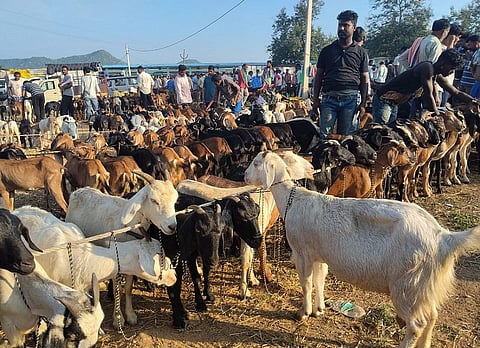Kurumpuri goat market, in Odisha’s Nuapada district, plays a significant role in region’s rain-fed agricultural and livestock economy
The Kurumpuri goat market in Nuapada district, Odisha, is a vital hub for livestock trade, attracting buyers from nearby districts and states.
It plays a significant role in the region's agricultural economy, especially during festivals like Nuakhai and Chhadakhai, when demand for goats and sheep surges.
Managed by the Regulated Market Committee, it contributes substantially to local revenue.
It is early morning in Western Odisha’s Nuapada district, around 463 kilometres away from the state capital Bhubaneswar. Kurumpuri market, a major trading point for goats and sheep, is bustling with livestock buyers from nearby districts such as Balangir, Kalahandi and Bargarh. Buyers from neighbouring Chhattisgarh and far away states like Andhra Pradesh also visit the goat market at Kurumpuri Panchayat in Nuapada block, which is held only once in a week on Thursday.
Native goat breeds commonly traded in the Kurumpuri market include Maraguda and Balangir. Similarly, native sheep breeds like Balangir and Dharmagarh mendha are also sold here. These breeds of goats and sheep are favoured for their meat quality, adaptability and reproductive traits. As a result, the market attracts buyers from other districts and states. The market runs fast, and farmers sell their animals at a fair price in a short time.
A social hub, vital for festival and ritual
The Kurumpuri market serves as a social hub, bringing together people from different villages and communities, fostering social interaction and the exchange of information. Western Odisha has a unique cultural significance of its own. The demand for goats and sheep increases particularly during festive periods like Nuakhai, Bihan Jatra and Chadakhai, when livestock sales surge due to religious and cultural practices.
Nuakhai, for instance, is an agricultural festival observed to welcome the season’s freshly harvested new rice. It is observed on panchami tithi (the fifth day) of the lunar fortnight of the months of August–September. Every farmer family needs money at that time to meet the basic essentials like new clothes. The farmers sell their goats and sheep in this market to meet the household expenses. Farmers buy livestock from this market to celebrate the very next day of Nuakhai as Nuakhai Basi. Eating meat on Nuakhai basi is a thousand-year-old tradition for the people.
Similarly, Bihan Jatra is a local festival celebrated in the month of December. The local priest distributes a handful of native seeds to the farmers to be sown in the next cropping season. The farmers worship their village deity and sacrifice the native goats, sheep and chicken for a bountiful harvest.
Chhadakhai is a vibrant festival observed on the day after Kartik Purnima, in the month of November. Traditionally, Kartik is considered as a pious month. Many people do not consume non-vegetarian food during this month. Chhadakhai means eating non-vegetarian food after Kartik Purnima. Since people do not consume non-vegetarian for the whole month of Kartik, they prefer to consume meat, chicken, and fish on the day after Kartik Purnima.
Management and administration
The Kurumpuri goat market is managed by the Regulated Market Committee (RMC), Khariar Road in Nuapada. The buyers need to pay three per cent of tax to the RMC on each animal. RMC officials are currently looking after the overall market operations.
According to Arya Kumar Muduli, RMC secretary, Khariar Road, the Kurumpuri goat market plays a crucial role in boosting the economy of the district. “During November-March, we collect high revenue from this market. On each market day, on an average 800 goats and sheep are sold, amounting to a turnover of Rs 36 lakh. RMC collects around Rs.1.08 lakh per market day during this period,” said Muduli.
In the market, drinking water facilities are available for humans as well as livestock. However, there are areas which need government attention. Land levelling should be done to avoid water logging in the rainy season. “Tenders have been floated for the establishment of a proper shed to protect people and livestock from scorching heat and rain,” shared Muduli.
Importance of small ruminants
India is home to the world’s highest livestock population, about 535.78 million. India ranks second in the population of goats (148.88 million) and third in the population of sheep (74.26 millions), according to one source. Livestock plays a crucial role in the Indian economy. About 20.5 million people depend on livestock to sustain their livelihood. Livestock provides employment to about 8.8 per cent of the population in India, according to this source.
“Amidst the changing climate, small livestock like goat, sheep, poultry and fisheries could bolster livelihood of marginalised farmers,” said Suresh Kumar Vashishth, principal secretary, Fisheries and Animal Resources Development Department, Government of Odisha. “We are working to identify, document characteristics and facilitate registration of lesser known native breeds in Odisha,” said Ashwini Kumar Barik, programme officer-Livestock and Fisheries, Watershed Support Services and Activities Network, a non-profit that works with farmers practicising rain-fed agriculture in Nuapada.
Sailaja Prasad Nayak, Senior Programme Officer-Livestock, Watershed Support Services and Activities Network (WASSAN), Bhubaneswar, Odisha.
Akshya Kumar Nag, Block Programme Coordinator at CPSW-Kendubhata, Nuapada, Odisha.
Sana Datta Vasuki Satyanarayana, Livestock Expert, Watershed Support Services and Activities Network (WASSAN), Bhubaneswar, Odisha.
Views expressed are the authors’ own and don’t necessarily reflect those of Down To Earth

